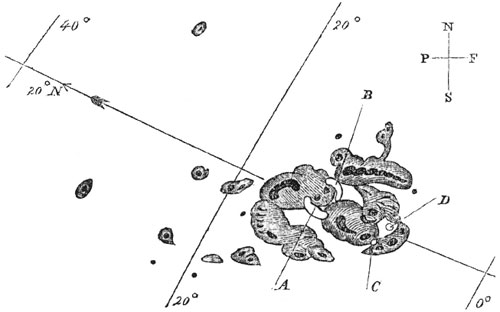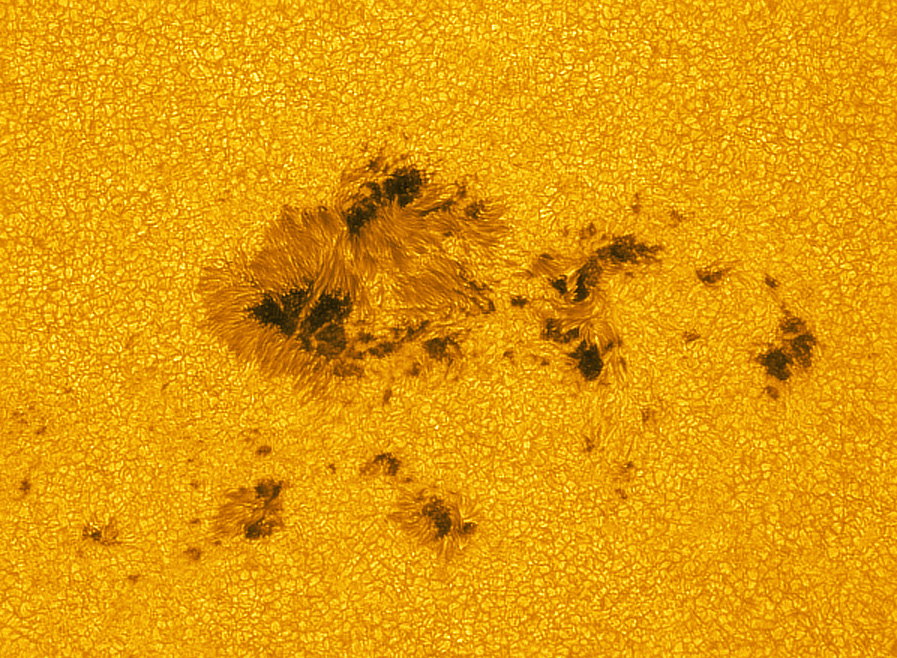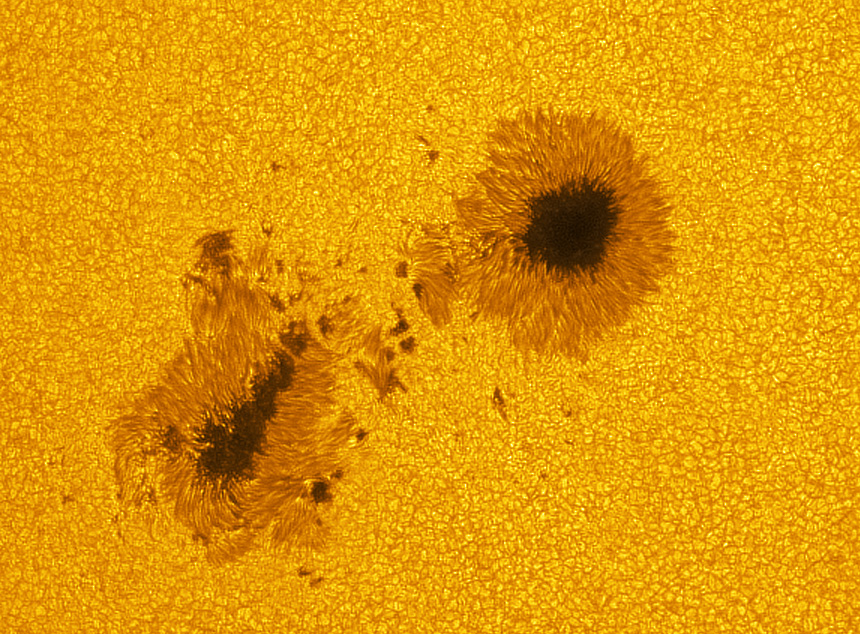The Carrington Event and Predictive Statistics:
Carrington’s Drawing of Sunspots, during of the Event in 1859.

From Wiki (checked and accurate):
The solar storm of 1859, also known as the Solar Superstorm,[1] or the Carrington Event,[2] which occurred during solar cycle 10, was the most powerful solar storm in recorded history, and the largest flare, observed by Richard Christopher Carrington, became known as the Carrington Super Flare.
Sunspots
From August 28, 1859, until September 2, numerous sunspots and solar flares were observed on the sun. Just before noon on September 1, the British astronomer Richard Carrington observed the largest flare,[3] which caused a massive coronal mass ejection (CME) to travel directly toward Earth, taking 17 hours. This is remarkable because such a journey normally takes three to four days. This second CME moved so quickly because the first one had cleared the way of the ambient solar wind plasma.[3]
Carrington Super Flare
On 1 September 1859, Carrington and Richard Hodgson, another English amateur astronomer, independently made the first observations of a solar flare. Because of a simultaneous “crochet” observed in the Kew Observatorymagnetometer record by Balfour Stewart and a geomagnetic storm observed the following day, Carrington suspected a solar-terrestrial connection. World wide reports on the effects of the geomagnetic storm of 1859 were compiled and published by Elias Loomis which support the observations of Carrington and Balfour Stewart.
Magnetic storm
On September 1–2, 1859, the largest recorded geomagnetic storm occurred. Aurorae were seen around the world, most notably over the Caribbean; also noteworthy were those over the Rocky Mountains that were so bright that their glow awoke gold miners, who began preparing breakfast because they thought it was morning.[3] People who happened to be awake in the northeastern US could read a newspaper by the aurora’s light.[4]
Telegraph systems all over Europe and North America failed, in some cases even shocking telegraph operators.[5] Telegraph pylons threw sparks and telegraph paper spontaneously caught fire.[6] Some telegraph systems appeared to continue to send and receive messages despite having been disconnected from their power supplies.[7]
[edit] News coverage
On September 3, 1859, the Baltimore American and Commercial Advertiser reported, “Those who happened to be out late on Thursday night had an opportunity of witnessing another magnificent display of the auroral lights. The phenomenon was very similar to the display on Sunday night, though at times the light was, if possible, more brilliant, and the prismatic hues more varied and gorgeous. The light appeared to cover the whole firmament, apparently like a luminous cloud, through which the stars of the larger magnitude indistinctly shone. The light was greater than that of the moon at its full, but had an indescribable softness and delicacy that seemed to envelop everything upon which it rested. Between 12 and 1 o’clock, when the display was at its full brilliancy, the quiet streets of the city resting under this strange light, presented a beautiful as well as singular appearance.”[8]
Similar events
Ice cores contain thin nitrate-rich layers that can be used to reconstruct a history of past events before reliable observations. These show evidence that events of this magnitude—as measured by high-energy proton radiation, not geomagnetic effect—occur approximately once per 500 years, with events at least one-fifth as large occurring several times per century.[9] Less severe storms have occurred in 1921 and 1960, when widespread radio disruption was reported.
The Carrington Event is the
From Our Friends at NASA:
A Super Solar Flare
+ Play Audio | + Download Audio | + Join mailing list
May 6, 2008: At 11:18 AM on the cloudless morning of Thursday, September 1, 1859, 33-year-old Richard Carrington—widely acknowledged to be one of England’s foremost solar astronomers—was in his well-appointed private observatory. Just as usual on every sunny day, his telescope was projecting an 11-inch-wide image of the sun on a screen, and Carrington skillfully drew the sunspots he saw.
Right: Sunspots sketched by Richard Carrington on Sept. 1, 1859. Copyright: Royal Astronomical Society: more.
On that morning, he was capturing the likeness of an enormous group of sunspots. Suddenly, before his eyes, two brilliant beads of blinding white light appeared over the sunspots, intensified rapidly, and became kidney-shaped. Realizing that he was witnessing something unprecedented and “being somewhat flurried by the surprise,” Carrington later wrote, “I hastily ran to call someone to witness the exhibition with me. On returning within 60 seconds, I was mortified to find that it was already much changed and enfeebled.” He and his witness watched the white spots contract to mere pinpoints and disappear.
It was 11:23 AM. Only five minutes had passed.
Just before dawn the next day, skies all over planet Earth erupted in red, green, and purple auroras so brilliant that newspapers could be read as easily as in daylight. Indeed, stunning auroras pulsated even at near tropical latitudes over Cuba, the Bahamas, Jamaica, El Salvador, and Hawaii.
Even more disconcerting, telegraph systems worldwide went haywire. Spark discharges shocked telegraph operators and set the telegraph paper on fire. Even when telegraphers disconnected the batteries powering the lines, aurora-induced electric currents in the wires still allowed messages to be transmitted.
“What Carrington saw was a white-light solar flare—a magnetic explosion on the sun,” explains David Hathaway, solar physics team lead at NASA’s Marshall Space Flight Center in Huntsville, Alabama.
Now we know that solar flares happen frequently, especially during solar sunspot maximum. Most betray their existence by releasing X-rays (recorded by X-ray telescopes in space) and radio noise (recorded by radio telescopes in space and on Earth). In Carrington’s day, however, there were no X-ray satellites or radio telescopes. No one knew flares existed until that September morning when one super-flare produced enough light to rival the brightness of the sun itself.
“It’s rare that one can actually see the brightening of the solar surface,” says Hathaway. “It takes a lot of energy to heat up the surface of the sun!”
Above: A modern solar flare recorded Dec. 5, 2006, by the X-ray Imager onboard NOAA’s GOES-13 satellite. The flare was so intense, it actually damaged the instrument that took the picture. Researchers believe Carrington’s flare was much more energetic than this one.
The explosion produced not only a surge of visible light but also a mammoth cloud of charged particles and detached magnetic loops—a “CME”—and hurled that cloud directly toward Earth. The next morning when the CME arrived, it crashed into Earth’s magnetic field, causing the global bubble of magnetism that surrounds our planet to shake and quiver. Researchers call this a “geomagnetic storm.” Rapidly moving fields induced enormous electric currents that surged through telegraph lines and disrupted communications.
“More than 35 years ago, I began drawing the attention of the space physics community to the 1859 flare and its impact on telecommunications,” says Louis J. Lanzerotti, retired Distinguished Member of Technical Staff at Bell Laboratories and current editor of the journal Space Weather. He became aware of the effects of solar geomagnetic storms on terrestrial communications when a huge solar flare on August 4, 1972, knocked out long-distance telephone communication across Illinois. That event, in fact, caused AT&T to redesign its power system for transatlantic cables. A similar flare on March 13, 1989, provoked geomagnetic storms that disrupted electric power transmission from the Hydro Québec generating station in Canada, blacking out most of the province and plunging 6 million people into darkness for 9 hours; aurora-induced power surges even melted power transformers in New Jersey. In December 2005, X-rays from another solar storm disrupted satellite-to-ground communications and Global Positioning System (GPS) navigation signals for about 10 minutes. That may not sound like much, but as Lanzerotti noted, “I would not have wanted to be on a commercial airplane being guided in for a landing by GPS or on a ship being docked by GPS during that 10 minutes.”
Right: Power transformers damaged by the March 13, 1989, geomagnetic storm: more.
Another Carrington-class flare would dwarf these events. Fortunately, says Hathaway, they appear to be rare:
“In the 160-year record of geomagnetic storms, the Carrington event is the biggest.” It’s possible to delve back even farther in time by examining arctic ice. “Energetic particles leave a record in nitrates in ice cores,” he explains. “Here again the Carrington event sticks out as the biggest in 500 years and nearly twice as big as the runner-up.”
These statistics suggest that Carrington flares are once in a half-millennium events. The statistics are far from solid, however, and Hathaway cautions that we don’t understand flares well enough to rule out a repeat in our lifetime.
And what then?
Lanzerotti points out that as electronic technologies have become more sophisticated and more embedded into everyday life, they have also become more vulnerable to solar activity. On Earth, power lines and long-distance telephone cables might be affected by auroral currents, as happened in 1989. Radar, cell phone communications, and GPS receivers could be disrupted by solar radio noise. Experts who have studied the question say there is little to be done to protect satellites from a Carrington-class flare. In fact, a recent paper estimates potential damage to the 900-plus satellites currently in orbit could cost between $30 billion and $70 billion. The best solution, they say: have a pipeline of comsats ready for launch.
Humans in space would be in peril, too. Spacewalking astronauts might have only minutes after the first flash of light to find shelter from energetic solar particles following close on the heels of those initial photons. Their spacecraft would probably have adequate shielding; the key would be getting inside in time.
No wonder NASA and other space agencies around the world have made the study and prediction of flares a priority. Right now a fleet of spacecraft is monitoring the sun, gathering data on flares big and small that may eventually reveal what triggers the explosions. SOHO, Hinode, STEREO, ACE and others are already in orbit while new spacecraft such as the Solar Dynamics Observatory are readying for launch.
Research won’t prevent another Carrington flare, but it may make the “flurry of surprise” a thing of the past.
Now, according to the Scientists, there is a 12% chance of another Carrington Event in the next Solar Max:
SPACE WEATHER: THE INTERNATIONAL JOURNAL OF RESEARCH AND APPLICATIONS, VOL. 10, S02012, 12 PP., 2012
doi:10.1029/2011SW000734On the probability of occurrence of extreme space weather events
Key Points
- Probability of a Carrington event occurring over next decade is ~12%
- Space physics datasets often display a power-law distribution
- Power-law distribution can be exploited to predict extreme events
Pete Riley
Predictive Science, San Diego, California, USA
By virtue of their rarity, extreme space weather events, such as the Carrington event of 1859, are difficult to study, their rates of occurrence are difficult to estimate, and prediction of a specific future event is virtually impossible. Additionally, events may be extreme relative to one parameter but normal relative to others. In this study, we analyze several measures of the severity of space weather events (flare intensity, coronal mass ejection speeds, Dst, and >30 MeV proton fluences as inferred from nitrate records) to estimate the probability of occurrence of extreme events. By showing that the frequency of occurrence scales as an inverse power of the severity of the event, and assuming that this relationship holds at higher magnitudes, we are able to estimate the probability that an event larger than some criteria will occur within a certain interval of time in the future. For example, the probability of another Carrington event (based on Dst < −850 nT) occurring within the next decade is ∼12%. We also identify and address several limitations with this approach. In particular, we assume time stationarity, and thus, the effects of long-term space climate change are not considered. While this technique cannot be used to predict specific events, it may ultimately be useful for probabilistic forecasting.
We are entering Solar Max at this time:



Other Reference:
http://reason.com/blog#article_156265
http://en.wikipedia.org/wiki/Power_law
http://arxiv.org/pdf/0706.1062.pdf









